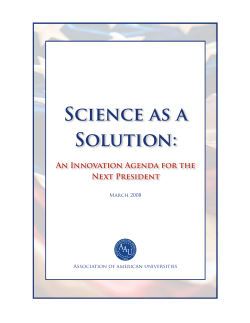
Document 1802
UNDERSTANDING UNIVER SITY An association of 63 leading public and private research universities TECHNOLOGY TRANSFER Brandeis University Brown University California Institute of Technology Carnegie Mellon University Case Western Reserve University Columbia University Cornell University Duke University Emory University Georgia Institute of Technology Harvard University Federal government agencies provide about $33 billion a year to universities to conduct scientific research. That continuing investment expands human knowledge and helps educate the next generation of science and technology leaders. New discoveries from university research also form the basis for many new products and processes that benefit the nation and its citizens. In fact, in the knowledge economy, technological innovation and the scientific research on which it is based are critical for much of the nation’s productivity growth. Indiana University Iowa State University The Johns Hopkins University Massachusetts Institute of Technology McGill University Michigan State University New York University Northwestern University New products and processes do not spring fully formed from the basic research performed at universities. They require not only discoveries or good ideas but also further development, capital, manufacturing capability, and marketing. Universities and other organizations use the process of technology transfer to move scientific findings to the private sector for further development and commercialization. The Ohio State University The Pennsylvania State University Princeton University Purdue University Rice University Rutgers, The State University of New Jersey Stanford University Stony Brook University - State University of New York The human capital aspect of technology transfer is often undervalued, but students and faculty are usually the most effective means of translating research discoveries into new technologies. Many of the most successful university-industry interactions are based on the education and training of students who have the knowledge and skills to meet industry needs, or on relationships that faculty members have developed with particular companies. Syracuse University Texas A&M University Tulane University How Does University Technology Transfer Work? The University of Arizona University at Buffalo, The State University of New York University of California, Berkeley University of California, Davis University of California, Irvine University of California, Los Angeles University of California, San Diego University of California, Santa Barbara The University of Chicago University of Colorado at Boulder University of Florida University of Illinois at Urbana-Champaign The University of Iowa Nonprofit organizations, including universities, may patent and retain title to inventions created from research funded by the federal government. In general, a university must disclose each new invention to the federal funding agency within two months of the inventor’s disclosing it to the university; decide whether or not to retain title to the invention; and then, within one year of electing to seek title, file a patent application. Universities must offer to license the rights to innovations to industry for commercial development; small businesses receive preference. The federal government also receives a nonexclusive, irrevocable license to the invention. Universities must share with the inventor any income eventually derived from the patent. Any remaining income, after technology management expenses, must support scientific research or education. __ Facts The University of Kansas University of Maryland, College Park University of Michigan How Does the Public Benefit From Technology Transfer? University of Minnesota, Twin Cities University of Missouri-Columbia University of Nebraska-Lincoln The University of North Carolina at Chapel Hill University of Oregon University of Pennsylvania University of Pittsburgh University of Rochester University of Southern California The University of Texas at Austin University technology transfer has helped create new industries and opened new markets. Products developed from university technology transfer include the gene splicing technology that effectively created the biotechnology industry, diagnostic tests for breast cancer and osteoporosis, vaccines, faster computer modems, new Internet search engines, improved building materials, and environmentally friendly technologies. Some examples of societal benefits from university research are available on the AAU website and on the website of the Association of University Technology Managers. University of Toronto University of Virginia University of Washington The University of Wisconsin-Madison Vanderbilt University Washington University in St. Louis Yale University 1200 New Yo r k A ve., NW S u ite 550 Was h ingt on, DC 20005 202-408-7500 f ax: 202 -408 -8184 www .aau .edu What is the Bayh-Dole Act? In the 1960s and 1970s, there was great concern that too little federally funded research was being commercialized. Tight restrictions on licensing, varying patent policies among federal agencies, and the lack of exclusive manufacturing rights for government-owned patents made product development a risky proposition for companies. In 1980, only five percent of government-owned patents resulted in new or improved products. To remedy this bottleneck, the Congress in 1980 passed the Bayh-Dole Act. The Act established a uniform government patent policy that allowed universities and other nonprofit organizations to retain title to federally funded inventions and to work with companies in bringing them to market. The Act thus promoted technology transfer by creating incentives for university researchers to consider the practical applications of their discoveries, and for universities to search out potential companies to develop them. By enabling corporations to negotiate exclusive licenses of promising technologies, the Act encouraged them to invest in the additional research, development, and manufacturing capabilities needed to bring new products to market. Has Bayh-Dole Succeeded? Before passage of the Bayh-Dole Act, fewer than 250 patents were issued to U.S. universities each year. Since passage of the Act, patents derived from university research have grown at an impressive rate. Already, in 1985, the U.S. Patent and Trademark Office awarded around 500 patents to the top 200 U.S. research institutions. Today, the most recent licensing survey by the Association of University Technology Managers (AUTM) shows that in FY 2009 alone, research discoveries made at academic institutions led to the execution of more than 4,600 licenses and options, the introduction of 658 new commercial products, and the formation of 555 new companies. An October 2010 report issued by the National Research Council also found that the system put in place by the Bayh-Dole Act has been effective. Another principal value of having universities retain control of patent rights is that it ensures that research findings remain freely available to the public and to further advance science in the laboratory and education in the classroom. How Do Universities Use Royalties From Licensed Technologies? Licenses and royalties from the initial results of university research are rarely large because most of the technology is rudimentary and risky, thus requiring considerable additional investment to turn it into a useful product or process. Larger fees and royalty rates can be negotiated for those few technologies that have clear commercial applications and large potential markets. When universities receive fees, they use them to cover expenses for technology transfer activities, such as paying a portion of legal fees associated with patenting and licensing and supporting the technology transfer office. Universities also share royalties with university inventors, and reinvest the remaining revenues for such activities as supporting graduate students, purchasing research equipment, and funding additional research. Can there Be Too Much Emphasis On University Technology Transfer? While universities need to make every effort to ease the transition of ideas into inventions, shifting federal investment at universities from basic to applied or targeted research, which might lead more quickly to commercial applications, would threaten the system of innovation by constricting the wellsprings of creativity and undermining confidence in the ultimate importance of basic research itself. 1200 New Yo r k A ve., NW S u ite 550 Was h ingt on, DC 20005 202-408-7500 f ax: 202 -408 -8184 www .aau .edu More broadly, many states and regions see research universities, particularly public institutions, not only as an essential element of their innovation initiatives but as the primary driver in that process. While universities do play a critical role, it is important that demands not be placed on them that divert them from their fundamental roles of education, research, and service. --Association of American Universities, January, 2011 1200 New Yo r k A ve., NW S u ite 550 Was h ingt on, DC 20005 202-408-7500 f ax: 202 -408 -8184 www .aau .edu
© Copyright 2025





















